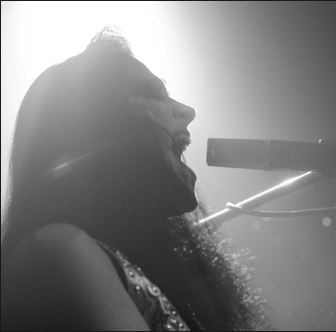By Todd Simmons
Diamanda Galás
Remaining Shows: August 19 (“Chansons Malheureuses and Amanedhes”)
The Highline Ballroom
431 W. 16th St between 9th and 10th Aves.
(212-414-5994; highlineballroom.com)
There were moments at the Highline Ballroom last Monday when the volcanic mouth of Diamanda Galás seemed to be a portal for the clamor of ancient, imperiled civilizations to come bursting out, seeking vengeance on the living with a furious uproar. At other times it was the creaky door to a haunted house emitting ghoulish noise. In the course of performing her “Imitation of Life” program, the wildly talented singer/pianist managed to captivate, startle and ultimately entertain the capacity crowd with her strong presence and fierce, otherworldly voice. The longtime East Villager with Greek Orthodox roots moved from kittenish to killer with astonishing ease as ghostly wisps of smoke snaked through the stage lights and collected around the grand Steinway piano.
“Imitation of Life” consisted of jazz standards and French ballads about the thrill and pain of romantic love and the torture we sometimes endure to partake in it. Diamanda’s harrowing delivery made a very convincing case that she knows of which she sings. And from the woman who once wrote and performed a piece entitled “Discussion Concerning the Composition of Wild Women with Steak Knives,” one can be sure that these aren’t sniveling love songs. The setlist (which she performed again on August 12 at the Highline) consisted of reinventions of songs made famous by the likes of Jacques Brel, Chet Baker, Edith Piaf and Marlene Dietrich, among others. Having lived in Berlin, London and Paris before settling in Manhattan eighteen years ago, she has a firm grasp on the international flavor of these songs.
With glitter-flecked, black smudged make up and dangling earrings that were like tiny chandeliers, the dark clad diva quietly entered the stage and sat behind the grand piano. With emphatic fingers she began casting her spell upon the captive audience with her notorious fervor. The relatively new venue is large enough to let her vocals expand and resonate but small enough to risk shattering the bar contents when her voice revved up to full throttle. From growling lows to dizzying highs, the voice of Galás remains one of the most powerful vessels of sound we’ve ever encountered.
With her long, black hair cascading down her shoulders, she plays the Steinway like a stranger banging frantically on your backdoor in the middle of the night with an emergency to report. It creates a terrifying effect. Yet despite the veritable pounding the instrument receives during her performances, she is very protective of it. After several songs she commented that this “beautiful baby” hadn’t been kept up properly and some of the velvet had worn off the hammers. “I don’t have children — but I value pianos,” she said, defending the Steinway like a neglected child. “It’s like playing bone on bone and I don’t like to do that to a piano. It’s not nice, it’s not nice, it’s not nice,” she repeated.
She gave no such speech in defense of the crowd’s eardrums, which were under fire during peak moments throughout. Her chilling shrieks on “You Don’t Know What Love Is” was mind-boggling. The sounds she created with her body were so compelling that, aside from a few patrons in the crowd who scrambled to plug their ears for fear of rupture, one couldn’t help but submit to the danger. Like surfing a large wave or dashing to beat a red light, the perverse thrill is a temptation one must give into despite the potential for blowback. Thanks to an excellent sound mix that accentuated Diamanda’s voice with subtle reverb and delay, she was able to push the boundaries of sound without any apparent damage to her faithful audience. (As far as we know.)
When asked if she’d ever actually broken any glass with her high notes, she said, “Just the ones I’ve broken with my hands during earnest conversation, but then, how typical.”
Leave it to the ethnomusicologists to debate her style or technique. With nearly 30 years of music in her arsenal and projects ranging from French opera to a poignant mass for victims of AIDS to a near rock’n’ roll collaboration with Led Zeppelin bassist John Paul Jones, she is truly beyond classification. She shifts from haunting Middle Eastern melodies and operatic bel canto to downtown scream performance art in graceful swoops. And her turbulent work — gently intimate cabaret soloing shattered by violent outbursts, like a soul attempting to free itself from a jagged trap — feels somehow more contemporary now than ever before. On Monday night, her encore version of “The Thrill Is Gone” emphatically proved that the thrill is most assuredly still there.





































